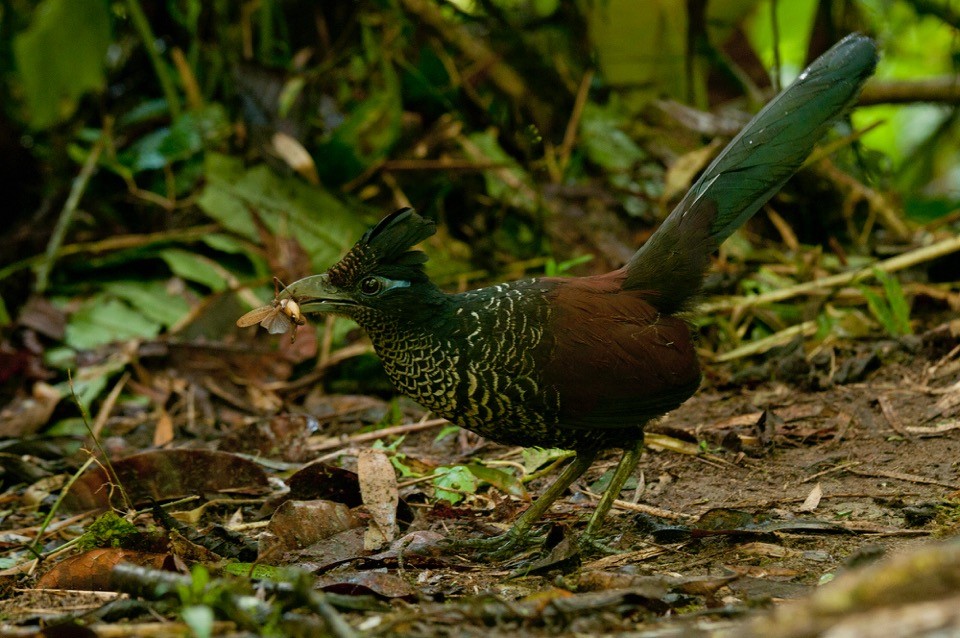Global Birdfair supporting efforts to save Ecuador’s Chocó‑Andes

At the intersection of two of the world’s most diverse bioregions, Ecuador’s Chocó- Andes is truly one of the most amazing ecosystems. However, it is also one of the most threatened, and funds at this year’s Global Birdfair will help protect a range of endemic and threatened species in this unique corner of the globe.
By Liam Hughes
Header image: The Chocó-Andes is one of the world’s hotspots for endemic species © Juan Carlos Valarezo
In 2006, while surveying the high altitude cloudforests of the remote Toisán range of Ecuador’s Chocó- Andes, a pocket-sized bird fluttering along the mist-shrouded ridgeline caught the eye of ornithologist Olaf Jahn. Looking closer, he soon realised he was staring at one of Ecuador’s rarest hummingbirds, Black-breasted Puffleg. At the time, the species was considered Critically Endangered and known only from one other site, although old museum specimens suggested that a remnant population may have occurred here.
Such is the remoteness of the area, requiring journeying up winding dirt roads to 3,000m above sea level, that it wasn’t until 2018 when BirdLife’s Ecuadorian partner Aves y Conservación returned. Thanks to support from BirdLife’s Conservation Leadership Programme, a team extensively surveyed the area, recording the puffleg at four seperate locations across the highlands of the Intag-Toisán Important Bird and Biodiversity Area (IBA).
This likely makes these fog-shrouded forests the global stronghold for the species, and warranted it being downlisted to Endangered on the IUCN Red List. “The new records in the Toisán mountain range mean a lot, as for many years Black-breasted Puffleg wasn’t known in the area,” said Luis Calapi, an ornithologist that took part in the survey. “It’s now a conservation tool for these forests and other species in danger of losing habitat.”

was instrumental in the species being named Quito’s emblematic bird © Murray Cooper
Spectacular diversity
In what is a testament to the extraordinary natural riches of this corner of the globe, the rediscovery merely adds to a seemingly ever-growing list of significant finds in the Chocó-Andes of north- western Ecuador. This 18,500km2 stretch of wet mountainous forests that surround the country’s capital, Quito, are at the meeting point of the tropical Andes and the wider Chocó bioregion, an area that extends along the Pacific coastline into neighbouring Colombia.
Renowned for its extraordinary biodiversity, the Chocó is home to around 3% of the world’s plant species and an impressive 63 bird species found nowhere else on Earth. This is a higher density of endemic birds than anywhere else in the Americas – a significant accolade considering its counterparts of the Amazon and Atlantic forests.
Home to numerous threatened species, the Chocó-Andes is truly a birder’s paradise. Among its number, Great Green Macaw and the enigmatic Banded Ground-cuckoo can be found in the tropical lowland forests, Black-and-chestnut Eagle and Cloudforest Pygmy-owl as you begin to climb the Andean foothills, while Black-breasted Puffleg hovers in cloudforests straddling the treeline. It is also vital to forest-dependent migratory birds, providing refuge to species such as Cerulean and Canada Warblers. Along with this rich natural diversity, the forests provide crucial benefits to more than 1 million people living in the vicinity.
Given this rich natural and cultural importance, protecting these forests has long been a priority of BirdLife and its two Ecuadorian partners, Aves y Conservación and Fundación Jocotoco. Excitingly, they are in the process of boosting their work in the region, having recently developed a Conservation Investment Strategy (CIS), a comprehensive 10-year plan for the protection of these rugged, wet forests, and this year’s Global Birdfair will be raising funds to kickstart part of it.


Time to act
The new strategy comes at a crucial time. Along with being one of the world’s most biodiverse regions, the Chocó-Andes is also one of the most threatened. Decades of deforestation and land use change have led to more than 60% of these forests being lost, driven by expanding oil palm plantations and cattle pastures, industrial logging activities and mining. Much of this has centred around the region’s lowland forests, of which just three large remnants remain.
Mining, now a key economic sector in Ecuador, has become an increasing threat, and there are around 90 large-scale concessions throughout these mountainous forests. The cloudforests of the Intag Valley – where the sub-population of Black-breasted Puffleg was rediscovered – have been a particular target for mining companies, with a string of concessions being proposed in the area since the 1990s. These have been arduously countered by local communities defending their land.
The latest case was in March this year, when the provincial court ruled against a large-scale copper mining project in the heart of the Intag-Toisán IBA, citing that the communities’ constitutional right to consultation had been violated, as had the rights of nature. The ruling came after months of hearings and delays in a case led by local communities – with support from the Key Biodiversity Area Red Flag group – against the concession.
The case is a testament to the power of local and Indigenous communities defending their land and the rights of nature, but it also highlights the urgency of safeguarding these forests. To do so, BirdLife and its Ecuadorian partners brought together more than 40 different stakeholders – ranging from academics and community members to representatives from the private sector – to develop its strategy.
Demonstrating the collaborative spirit needed for 21st century conservation, alongside leading Ecuadorian ornithologists, they identified 11 flagship species, using these to earmark more than 850,000ha of priority forests to protect and restore. The CIS also outlines the major threats facing these birds, identifying nine strategies to reduce these, ranging from creating protected areas and restoring key habitat to supporting local communities in legally defending their lands.
“Thanks to the hard work and conservation wins that Aves y Conservación and Fundación Jocotoco have delivered for the Chocó-Andes region, and the relationships with government institutions, local communities, NGOs and researchers that we have built, we are now well placed to deliver co-ordinated and impactful interventions across this landscape,” said Michael Seager, BirdLife’s Forest Programme Manager for the Americas.


Protecting mountaintops
Funds raised at 2023’s Global Birdfair will be used to support the Aves y Conservación component of the strategy, centred around protecting the recently rediscovered population of Black-breasted Puffleg. Following its surveys, the organisation bought 105ha of these remote cloudforests, establishing the Kinti Toisán reserve. The reserve is a combination of intact and degraded forest, with areas of a former cattle pasture.
The organisation is therefore aiming to use the funds to restore these degraded areas, in turn increasing suitable breeding habitat for the Endangered Black-breasted Puffleg. As it lies in the north-eastern buffer of Cotacachi Cayapas Ecological Reserve – which at 200,000ha encompasses some of the most significant remnants of the Chocó-Andes – by restoring these remote forests, Aves y Conservación will also create an important wildlife corridor between it and nearby national and municipal protected areas.
“Alongside Cotacachi Cayapas, we will produce native plants that are part of the puffleg’s diet to enrich areas currently degraded and converted into cattle pastures,” said Juan Carlos Valarezo, Executive Director of Aves y Conservación. “The restoration process will have strong participation from the local population, both through the involvement of residents of the area in the propagation of plants and during planting.”
Aves y Conservación is also hoping to use funds raised to bolster infrastructure on the reserve, allowing it to host researchers and adventurous birders hoping to glimpse one of Ecuador’s rarest hummingbirds. This will not only allow experts to conduct a range of studies on this remote, little- studied ecosystem, but also provide a much-needed economic boost to local communities in one of Ecuador’s poorest regions.
“Conservation organisations must demonstrate in practice how nature conservation actions have tangible and direct benefits in improving people’s living conditions,” said Valarezo. “Birdwatching and scientific tourism promotes community conservation, [and] empowering communities and providing them with sustainable economic opportunities creates interest and ownership in protecting nature.”


From sea level to treeline
Meanwhile, BirdLife’s other Ecuadorian partner Fundación Jocotoco is working extensively on the other side of the Cotacachi Cayapas Reserve, in the lowland Chocó rainforests. Here, the organisation manages the 8,668ha Canandé Reserve, protecting some of Ecuador’s most important populations of species, such as Great Green Macaw, Baudo Guan (Endangered) and Great Curassow (Vulnerable). It’s also a haven for a host of species from other groups. Through its canopy swing Endangered Brown-headed Spider Monkeys – a primate that numbers fewer than 500 individuals – while Jaguars (Near Threatened) patrol its forest floor.
The reserve, which is one of few protected areas in these lowland forests, is also home to the Chocó lab, a research station established by Fundación Jocotoco in 2020. Since then, various world-leading experts have visited to conduct research on identifying new ways of monitoring birds using bioacoustics, studying threatened species such as Banded Ground-cuckoo and measuring forest recovery, which has shown promising signs.
“We have been purchasing land and protecting the forest of Canandé now for over 20 years, and encouragingly, researchers at our in-situ laboratory have measured the incredible ability of former pastureland and timber concessions to regrow relatively quickly into secondary forests,” said Veronica Enriquez, National Director of Fundación Jocotoco. “But due to the continuing pressure that the area faces, we recognise that we must act quickly and in co-ordination with a wider network of partners to achieve our goals of protecting the remaining primary forests in this area, and the astounding diversity of birds found here.”
As part of the new strategy, Fundación Jocotoco is planning to expand the Canandé reserve to fully connect it with the Cotacachi Cayapas Reserve and other nearby state-run protected areas. The move would lead to an impressive 300,000ha of continuous protected area, conserving around 800 bird species across a range of ecosystems spanning an altitudinal gradient of 50-4,900m.
The vital work by both BirdLife partners, whether through restoring remote cloudforests above 3,000m or protecting one of the area’s largest remaining remnants of lowland forests, is critical to conserving this imperilled biodiversity haven. The sheer altitudinal range of their work is also crucial to helping species adapt to what is going to become an ever-increasing threat – climate change.
“With climate change increasing average temperatures in tropical mountains across the world, scientists have now observed different assemblages of birds, plants and insects beginning to shift their distributions uphill to cooler areas,” said Seager. “It is increasingly apparent that protecting corridors that span large altitudinal gradients will be an important measure to help species in the Tropical Andes adapt to climate change.”


for the pet trade has driven Great Green Macaw to Critically Endangered status © Michael Moens
Global Birdfair: A force for conservation

Supporting efforts to protect and restore important Black-breasted Puffleg habitat is the latest to have funds raised at Global Birdfair in the UK. At last year’s inaugural event, an impressive 100,000 euros was raised to restore La Janda. Once Spain’s largest seasonal lagoon and historically one of the most important wetlands in Europe, most of it was drained during the last century.
Held at the Rutland Showground, along with raising important funds for conservation, the event brought together a range of expert ornithologists, tour guides and conservation bodies from around the world, attracting more than 11,000 passionate birders. Much of this success is down to the extraordinary efforts of its founder, Tim Appleton MBE, whose work in this sector over more than 30 years has helped raise hundreds of thousands of pounds for conservation. Find out more about the event here.
